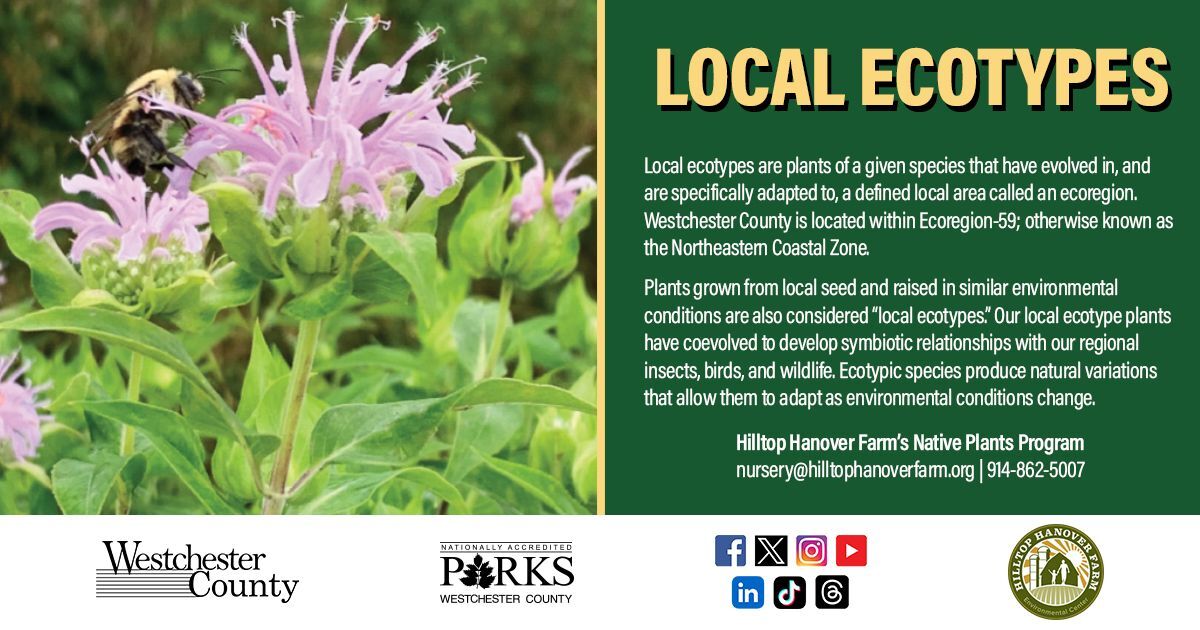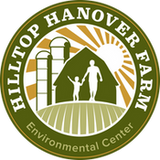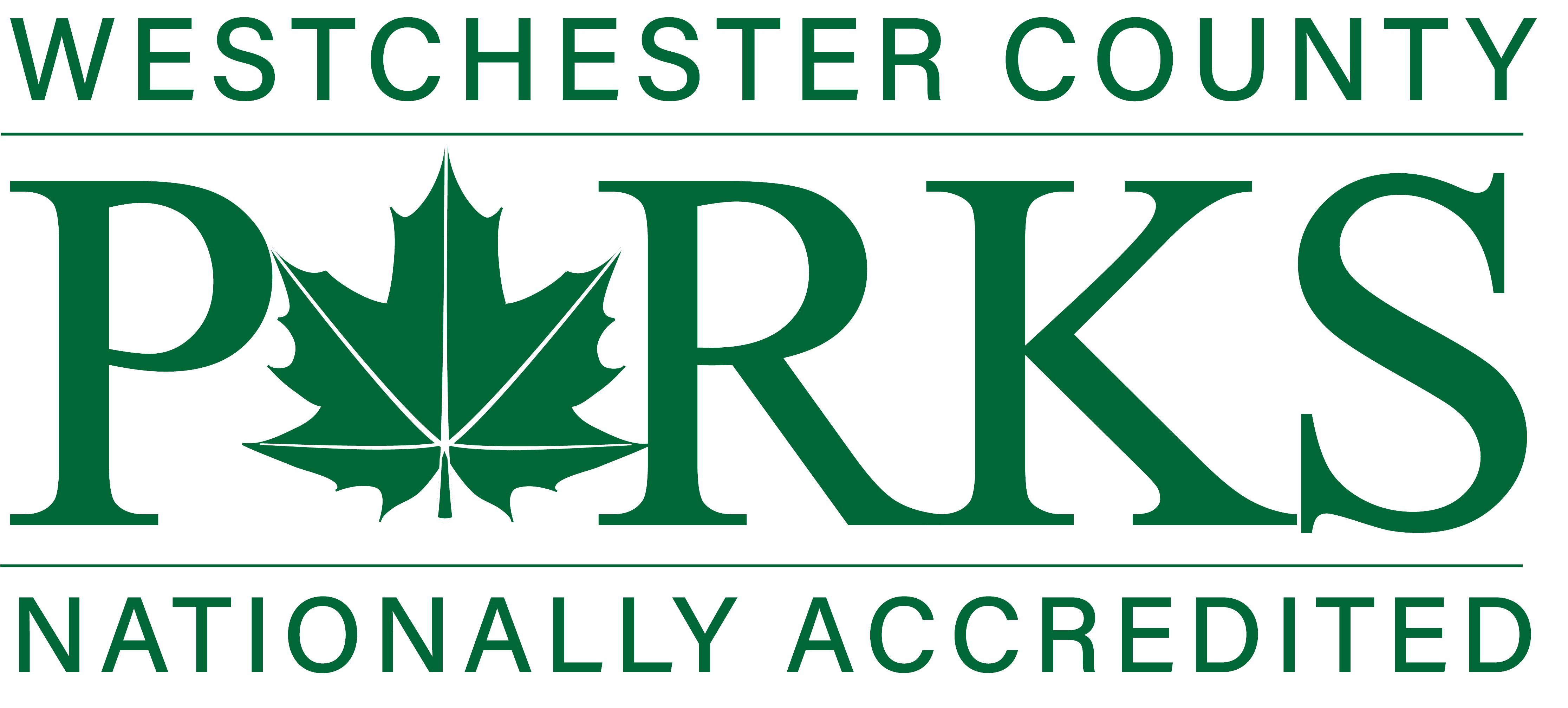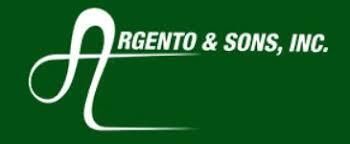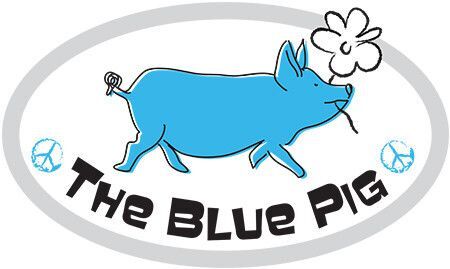Native Plants are sold through our Farm Stand.
We have adjusted our native plant growing schedule to more closely align with our species’ natural seasonal patterns. This will help lower plant stress, resulting in healthier and more resilient seedlings. Additional species will be available in the fall.
Some species now available in quart size. Inventory quantities are subject to change daily. For specific inventory questions, please call our Farm Stand, (914) 862-5034, or email Emily Rauch, nursery@hilltophanoverfarm.org.
-
 Narrowleaf Mountain Mint
Narrowleaf Mountain MintPycnanthemum tenuifolium
This vigorous mountain mint forms colonies and has clusters of showy white flowers. It has very narrow, needle like leaves that smell strongly of mint when crushed.
Height: 2-3ft
Bloom time: July-September
Sun: full sun to part shade
Soil: medium to dry
Wildlife value: attractive to many kinds of butterflies, bees, wasps, flies and beetlesDEER RESISTANT
LOCAL ECOTYPE*Original ecotype collected in Newtown, CT; seed grown out at Hilltop Hanover Farm.
_____ -
 Cardinal Flower
Cardinal FlowerLobelia cardinalis
Stunning wetland plant with erect, terminal spikes of bright scarlet red tubular flowers.
Height: 2-4ft
Bloom time: July-September
Sun: full sun to part shade
Soil: wet to medium wet
Wildlife value: important nectar source for hummingbirds and swallowtail butterfliesDEER RESISTANT
LOCAL ECOTYPE*Original ecotype collected in Redding, CT; seed grown out at Hilltop Hanover Farm.
_____ -
 Great Blue Lobelia
Great Blue LobeliaLobelia siphilitica
Showy, bright blue flowers form an elongated cluster on a leafy stem. Usually grows in moist to wet locations, but also does well in most rich garden soils. A nice late blooming addition to a pollinator or cottage garden as well as naturalized areas and pond borders.
Height: 2-3ft
Bloom time: July-October
Sun: full sun to part shade
Soil: wet to medium
Wildlife value: attracts bees, butterflies and hummingbirdsDEER RESISTANT
*Original ecotype collected in Clermont, NY; seed grown out at Hilltop Hanover Farm.
_____ -
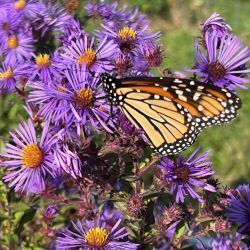 New England Aster
New England AsterSymphyotrichum novae-angliae
This large, showy aster is an important source of pollen and nectar long after summer blooming flowers have faded. Clusters of composite flowers consist of yellow disk florets surrounded by numerous lavender/purple ray florets. A great plant for a wildflower border, moist meadow or open area.
Height: 3-6 ft
Bloom Time: August- October
Sun: full sun to part shade
Soil: medium to moist
Wildlife value: visited by various bees, butterflies and skippers, larval food to many moths and butterfliesLOCAL ECOTYPE
*Original ecotype collected in Brookfield, CT; seed grown out at Hilltop Hanover Farm.
_____ -
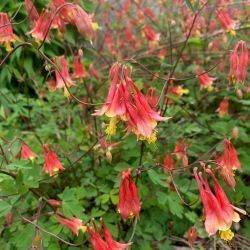 Eastern Red Columbine
Eastern Red ColumbineAquilegia canadensis
Woodland wildflower with showy red, drooping, bell shaped flowers. One of the first to provide nectar in the spring and flowering coincides with the return of migrating hummingbirds! Tolerates a wide range of soil and light conditions. Delicate foliage remains attractive throughout the growing season.
Height: 2ft
Bloom time: April-May
Sun: full sun to part shade
Soil: moist to dry
Wildlife value: Attracts hummingbirds, bees and butterflies, larval host plant to the Columbine Duskywing Butterfly and the Columbine Borer MothGood deer resistance
LOCAL ECOTYPE*Original ecotype collected in Dutchess/Columbia County, NY; seed grown out at Hilltop Hanover Farm.
_____ -
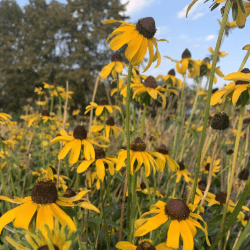 Black-Eyed Susan
Black-Eyed SusanRudbeckia hirta
This long blooming wildflower is a biennial or short-lived perennial. It freely self-seeds to persist for many years in the garden. Bright yellow daisy like flowers attract many pollinators.
Height: 2-3ft
Bloom time: June-October
Sun: Full sun
Soil: medium to dry
Wildlife value: A great source of pollen and nectar for bees, as well as butterflies, flies and beetles. A larval host plant for the Silvery Checkerspot ButterflyDEER RESISTANT
LOCAL ECOTYPE*Original ecotype collected in Newtown, CT; seed grown out at Hilltop Hanover Farm.
_____ -
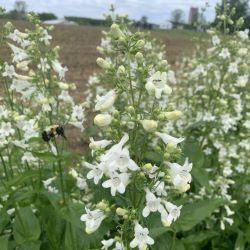 Foxglove Beardtongue
Foxglove BeardtonguePenstemon digitalis
Penstemon is a clump forming, fast growing prairie plant giving color to the garden in early spring. White to pinkish small tubular flowers grow on panicles atop rigid stems. Its distinct seed head and semi-evergreen basal foliage adds beautiful winter interest. Penstemon looks nice grouped together in a garden setting.
Height: 3-5ft
Bloom time: Late April-July
Sun: full to partial sun
Soil: medium to dry
Wildlife value: tubular flowers attracts many types of bees, wasps and flies.DEER RESISTANT
LOCAL ECOTYPE*Original ecotype collected in Redding, CT; seed grown out at Hilltop Hanover Farm.
_____ -
 Swamp Milkweed
Swamp MilkweedAsclepias incarnata
Large rose-colored clusters of flowers, smelling fragrantly of vanilla, sit atop upright, branching stems. Although usually a swamp plant, this milkweed grows surprisingly well in medium, regular garden soil. It is a great addition to any perennial wildflower garden, rain garden or situated near a pond.
Height: 2-5ft
Bloom time: June-September
Sun: full sun to part shade
Soil: average to wet
Wildlife value: very attractive to butterflies as a nectar source, larval host plant for the Monarch and Queen butterfliesDEER RESISTANT
LOCAL ECOTYPE
_____ -
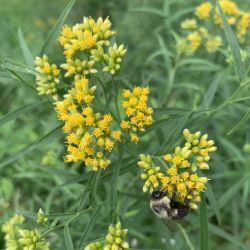 Thin Leaf Goldenrod
Thin Leaf GoldenrodEuthamia graminifolia
Rounded, flat top clusters of tiny yellow flowers adorn branching stems of this goldenrod. It's unique grass like foliage sets it apart from others in this family. It can sometimes be aggressive, so it's best placed where it has room to expand. Usually likes moist conditions but can be surprisingly drought tolerant.
Height: 3-5ft
Bloom time: July-September
Sun: full to part sun
Soil: wet to medium-dry
Wildlife value: attracts butterflies, bees, and beetles, birds feed off of the seeds,DEER RESISTANT
LOCAL ECOTYPE
_____ -
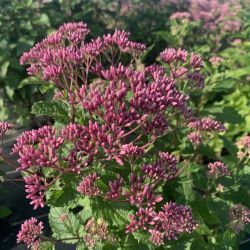 Joe Pye
Joe PyeEutrochium dubium
A tall perennial with strong stems that support large domed, pink to purple inflorescence. Can make a big architectural statement in the garden when grouped together in the back of a perennial bed. This species generally likes moist conditions but does well in average garden soil when given the room to grow.
Height: 5-7ft
Bloom time: July to September
Sun: full sun to part shade
Soil: medium to wet
Wildlife value: magnet for many species of butterfliesDEER RESISTANT
LOCAL ECOTYPE*Original ecotype collected in Redding, CT; seed grown out at Hilltop Hanover Farm.
_____ -
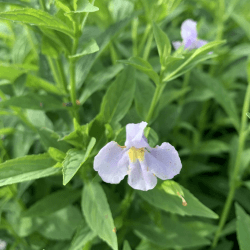 Allegheny Monkey Flower
Allegheny Monkey FlowerMimulus ringens
A subtle, bushy, wetland plant that naturalizes by spreading rhizomes and self-seeding. Great in wetlands or rain gardens. Called Monkey Flower because the small, blue-violet flower resembles a monkey's face.
Height: 1-3ft
Bloom time: June-September
Sun: sun to part shade
Soil: moist to wet
Wildlife value: Bumblebees visit the flower for nectar. It is a larval host plant to both the Common Buckeye and Baltimore Checkerspot butterflies and the Chalcedony Midget moth.DEER RESISTANT
LOCAL ECOTYPE
_____ -
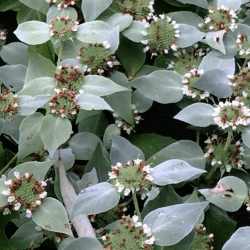 Short Toothed Mountain Mint
Short Toothed Mountain MintPycnanthemum muticum
A pollinator and insect magnet! This fast spreading, aromatic perennial smells strongly of mint, making it highly deer resistant. The flowers are subtle, but the leaves have a distinct silver color that give a nice glow when planted grouped together. It spreads by rhizomes and is great for naturalization.
Height: 1-3ft.
Bloom time: July-September
Sun: full to part sun
Soil: medium to dry
Wildlife value: attractive to many kinds of butterflies, bees, wasps, flies and beetlesDEER RESISTANT
LOCAL ECOTYPE*Original ecotype collected in Bethel, CT; seed grown out at Hilltop Hanover Farm.
_____ -
 Virginia Mountain Mint
Virginia Mountain MintPycnanthemum virginianum
Virginia mountain mint is the only mountain mint that likes to grow in wet soil, but will also tolerate regular garden soil. It is perfect for a rain garden or in wet meadows. Erect, branching stems have flat topped, terminal clusters of small white flowers. Same with all mountain mints, the leaves smell like mint when crushed.
Height: 2-3ft
Bloom time: July-September
Sun: full sun to part shade
Soil: medium to wet
Wildlife value: attractive to many kinds of pollinators, predators and parasitoids.DEER RESISTANT
LOCAL ECOTYPE
_____ -
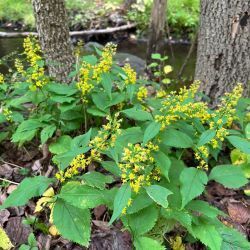 Blue Stem Goldenrod
Blue Stem GoldenrodSolidago caesia
This shade-tolerant goldenrod bears yellow flower clusters in the axils along it's purple/bluish stems. The branching, arching stems give this plant a graceful appearance. This goldenrod behaves in the garden and is not aggressive.
Height: 3ft
Bloom time: August - October
Sun: Medium- partial shade
Soil: Medium -medium dry
Wildlife value: the pollen and nectar attract a wide variety of insects, it is a larval host plant to beetles, a leafhopper and leaf-miner flies, many other insects feed off of this plant
_____ -
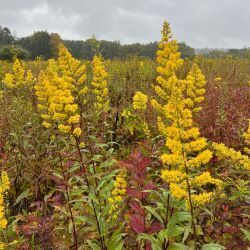 Showy Goldenrod
Showy GoldenrodSolidago speciosa
True to it's common name, this goldenrod's big, yellow inflorescence is 1 ft long and quite showy! The panicle, made up of small yellow compound flowers, sits atop smooth, erect central stems reddish in color.
Height: 2-3ft
Bloom Time: July- September
Sun: Full sun Soil: Medium to Dry
Wildlife Value: attracts honeybees, bumblebees, ants, beetles and the occasional moth or butterflyDEER RESISTANT
LOCAL ECOTYPE*Original ecotype collected in Bedford, NY; seed grown out at Hilltop Hanover Farm.
_____ -
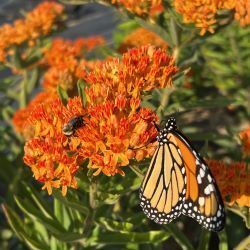 Butterfly Weed
Butterfly WeedAsclepias tuberosa
This milkweed is distinct for its showy, bright orange flower clusters. The low mounding habit along with its long mid-summer blooms make this a popular garden plant. Due to its drought tolerant tap root, it does well in sandy, loam soils. It can be late to emerge in the spring, so put a marker where it is planted! Plant in masses to attract Monarch butterflies. High deer and drought resistance.Height: 1-2ft
Bloom time: June-August
Sun: full sun
Soil: medium- dry
Wildlife value: attracts butterflies and hummingbirds and larval host plant for the Monarch & Queen butterflies and the Milkweed Tussock mothLOCAL ECOTYPE
_____ -
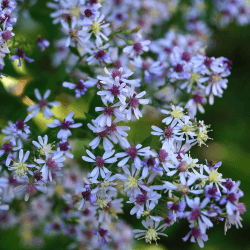 Blue Wood Aster
Blue Wood AsterSymphyotrichum cordifolium
This aster, usually found in woodland locations, is a nice addition to a naturalized shade garden. Pale to rich blue daisy-like flowers. Sometimes called heart leaf aster, named for heart shaped leaves found low on the stem.
Height: 2-5ft
Bloom time: August-November
Sun: part to full shade
Soil: medium to medium dry
Wildlife value: butterflies and beesDEER RESISTANT
LOCAL ECOTYPE
_____ -
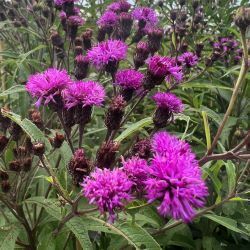 NY Ironweed
NY IronweedVernonia noveboracensis
Tall, coarse, upright perennial usually grows wild in moist thickets, lowlands or along stream banks. Great in the back of a perennial bed or wildflower garden. Terminal flower heads feature an attractive spray of many fluffy, deep purple flowers.
Height: 4-6ft
Bloom time: August-September
Sun: full sun
Soil: medium to wet
Wildlife value: flowers attract butterflies and seed heads attract birdsDEER RESISTANT
LOCAL ECOTYPE
_____ -
 Purpletop tridens
Purpletop tridensTridens flavus
Perennial warm season bunchgrass with drooping branches of reddish/purple spikelets. When planted en masse, it forms a stunning show of purple haze atop a field or meadow. Being salt tolerant makes it a good choice for roadside planting sites.
Height: 3-6ft
Bloom time: August-November
Sun: full to part sun
Soil: medium to dry
Wildlife value: host plant for a number of larvae, birds feast on the seedsDEER RESISTANT
LOCAL ECOTYPE
_____ -
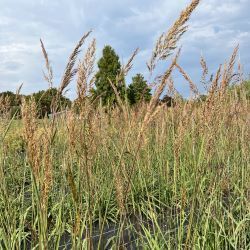 Indian Grass
Indian GrassSorghastrum nutans
A broader leaved grass with delicate yellow flowers that fits well behind and amongst flowers in meadow plantings. Original ecotype collected in Clermont, NY., seed grown out at Hilltop Hanover Farm in Yorktown Heights, NY.
Height: 3-8 feet
Bloom time: August-September
Sun: Full sun
Soil: dry to moist, deep well drained sandy loam
Wildlife value: Larval host plant to pepper-and-salt skipper butterfly. Seeds feed small mammals and birds. Ground cover and nesting site for songbirds and larger birds. Nesting material and structure for native bees.LOCAL ECOTYPE
*Original ecotype collected in Clermont, NY; seed grown out at Hilltop Hanover Farm.
______ -
 Little Bluestem
Little BluestemSchizachyrium scoparium
Ornamental warm season prairie grass which gets its name from the color of the stem base in spring. It turns a reddish brown color in the fall and forms a stunning display when planted en masse.
Height: 3ft
Bloom time: July-November
Sun: full sun to part shade
Soil: medium to dry, will not tolerate wetlands
Wildlife value: Seeds are eaten by songbirds, host plant to several species of skippersDEER RESISTANT
LOCAL ECOTYPE*Original ecotype collected in Somers, NY; seed grown out at Hilltop Hanover Farm.
_____
